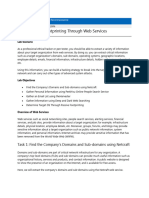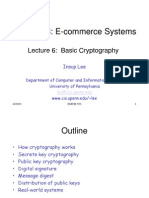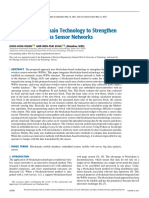Assignment 2 Network Security
Uploaded by
Louise ChristineAssignment 2 Network Security
Uploaded by
Louise ChristineAssignment 2
1. What are the properties that a cryptographic hash function must satisfy? Does a Message Authentication
Code (MAC) work as a Hashed Message Authentication Code (HMAC)? If that is, does a MAC satisfy
the same properties that an HMAC satisfies?
2. With respect to biometrics: What is the difference between the authentication problem and the
identification problem? Which is inherently easier, authentication or identification? Why?
3. Firewalls
a. Explain what is meant by the term firewall in network security and discuss how it is used
in network architectures.
b. What are the different types of firewalls?
c. At which layer of the Internet protocol stack does each of these firewalls operate and what
information is available to each of these firewalls?
4. Timestamps can be used in place of nonces in security protocols.
a. State an advantage and a disadvantage of using timestamps.
b. Explain the term “clock skew‟ and its importance towards designing security protocols.
5. What is a virus? What is a worm? Explain the differences between the two terms and give examples of
known viruses and worms.
6. What is a race condition? Give an example of a real-world race condition.
7. This problem deals with digital signatures.
a. Explain how and why a digital signature can provide integrity.
b. Explain how and why a digital signature can provide non-repudiation.
c. Does a digital signature ensure the entire message is encrypted? You should provide reasons to
support your answer.
8. Consider the elliptic curve:
E: y2 = x3 + 11x + 19 (mod 167).
a. Verify that the point P = (2, 7) is on E.
b. Suppose this E and P = (2, 7) are used in an ECC Diffie-Hellman key exchange, where Alice
chooses the secret value A = 1 and Bob chooses the secret value B = 3. What value does Alice
send to Bob? What does Bob send to Alice? What is the shared secret?
9. Suppose that you have a block cipher and want to use it as a hash function. Let X be a specified constant
and let M be a message consisting of a single block, where the block size is the size of the key in the
block cipher. Define the hash of M as Y = E(X, M). Note that M is being used in place of the key in
the block cipher.
a. Assuming that the underlying block cipher is secure, show that this hash function satisfies the
collision resistance and one-way properties of a cryptographic hash function.
b. Extend the definition of this hash so that messages of any length can be hashed. Does your hash
function satisfy all of the properties of a cryptographic hash?
c. Why must a block cipher used as a cryptographic hash be resistant to a "chosen key" attack?
Hint: If not, given plaintext P, we can find two keys K0 and K1 such that E(P,K0) = E(P,K1).
Show that such a block cipher is insecure when used as a hash function.
10. Explain what is meant by the term firewall in network security and discuss how it is used in
network architectures.
11. James and Alexander are having another debate about computer and network security. James says
that it is the job of security professionals to find all vulnerabilities and every threat and make sure
the system is always 100% secure. Do you agree with James? You should explain your answer
with reasons.
12. Explain why challenge response identification systems are used.
13. Explain what a nonce is and the reason for using a nonce.
14. In general, there are three types of identity authentication tasks. List these tasks.
15. Describe the three main concerns with the use of passwords for authentication. Explain what is
meant by a social engineering attack on a password.
16. Mention at least one attack related each layer in TCP/IP model.
17. Alice and Bob is using RSA Encryption Scheme. Bob wants to send the message M = 13 to Alice.
By using Alice's public and private keys, Calculate the cipher text C which will send by Bob and
show how Alice can recovers the message from received the cipher text C. (3p)
a. Alice's public key is (n; e) = (33; 3).
b. Alice's private key is (n; d) = (33; 7).
18. What is Cryptanalysis?
19. Is this protocol secure? You should provide reasons to support your answer. If this is not secure,
how do you fix it?
20. What are the key security issues in a blockchain network and briefly explain them?
You might also like
- CISA Dumps Isaca CISA: 100% Valid and Newest Version CISA Questions & Answers Shared by Certleader100% (1)CISA Dumps Isaca CISA: 100% Valid and Newest Version CISA Questions & Answers Shared by Certleader7 pages
- Principles of Computer Security: CompTIA Security+ and Beyond Lab Manual (Exam SY0-601)From EverandPrinciples of Computer Security: CompTIA Security+ and Beyond Lab Manual (Exam SY0-601)No ratings yet
- CISSP Exam Review Questions: Domain 1: Information Security and Risk ManagementNo ratings yetCISSP Exam Review Questions: Domain 1: Information Security and Risk Management89 pages
- Computer Security: Principles and PracticeNo ratings yetComputer Security: Principles and Practice36 pages
- Assignment No.5 Question No.1:: What Is The Difference Between A Block Cipher and A Stream Cipher? AnswerNo ratings yetAssignment No.5 Question No.1:: What Is The Difference Between A Block Cipher and A Stream Cipher? Answer2 pages
- Module 01 Introduction to Penetration TestingNo ratings yetModule 01 Introduction to Penetration Testing30 pages
- Data Communication &networks: Domain Name SystemNo ratings yetData Communication &networks: Domain Name System20 pages
- CS GTU Study Material Presentations Unit-1 02102020082427AMNo ratings yetCS GTU Study Material Presentations Unit-1 02102020082427AM63 pages
- Zarq Javed Gill - 70126247 - Assignment 4 - PPNo ratings yetZarq Javed Gill - 70126247 - Assignment 4 - PP5 pages
- Module 02 - Footprinting and Reconnaissance - Lab 2 - Perform Footprinting Through Web ServicesNo ratings yetModule 02 - Footprinting and Reconnaissance - Lab 2 - Perform Footprinting Through Web Services26 pages
- CEH Lesson 7 - Cryptographic Attacks and DefensesNo ratings yetCEH Lesson 7 - Cryptographic Attacks and Defenses23 pages
- EMTM 553: E-Commerce Systems: Lecture 6: Basic CryptographyNo ratings yetEMTM 553: E-Commerce Systems: Lecture 6: Basic Cryptography60 pages
- Hasanul Kabir Roll 2303225 - Lab01 HTTP Protocol Analysis With WiresharkNo ratings yetHasanul Kabir Roll 2303225 - Lab01 HTTP Protocol Analysis With Wireshark10 pages
- Application Vulnerabilities and DefencesNo ratings yetApplication Vulnerabilities and Defences12 pages
- DNS Packet Flow With DNSSEC Terminology: Public Key AlgorithmNo ratings yetDNS Packet Flow With DNSSEC Terminology: Public Key Algorithm1 page
- A Guide To Automating Threat Detection With MITRE ATT&CK - LogRhythmNo ratings yetA Guide To Automating Threat Detection With MITRE ATT&CK - LogRhythm9 pages
- Open Function: File - Object Open ("Filename", "Mode") Where File - Object Is The Variable To Add TheNo ratings yetOpen Function: File - Object Open ("Filename", "Mode") Where File - Object Is The Variable To Add The12 pages
- A-Guide-for-Beginners---Understand-Artificial-Intelligence-No ratings yetA-Guide-for-Beginners---Understand-Artificial-Intelligence-14 pages
- Regular Expressions: Python For EverybodyNo ratings yetRegular Expressions: Python For Everybody34 pages
- AWS Certified Security – Specialty (SCS-C02) Exam Guide: Get all the guidance you need to pass the AWS (SCS-C02) exam on your first attemptFrom EverandAWS Certified Security – Specialty (SCS-C02) Exam Guide: Get all the guidance you need to pass the AWS (SCS-C02) exam on your first attemptNo ratings yet
- Digital Evidence Forensic Report TemplateNo ratings yetDigital Evidence Forensic Report Template6 pages
- Secure High-Rate Transaction Processing in BitcoinNo ratings yetSecure High-Rate Transaction Processing in Bitcoin31 pages
- MBA Semester IV MCQ Information Security IVNo ratings yetMBA Semester IV MCQ Information Security IV11 pages
- Technical Introduction To Cybersecurity 1.0 Lesson ScriptsNo ratings yetTechnical Introduction To Cybersecurity 1.0 Lesson Scripts101 pages
- Download (Ebook) Cryptography and network security by Atul Kahate ISBN 9781259029882, 1259029883 ebook All Chapters PDFNo ratings yetDownload (Ebook) Cryptography and network security by Atul Kahate ISBN 9781259029882, 1259029883 ebook All Chapters PDF76 pages
- KIET Group of Institutions: (Information Technology) Btech, VI SemNo ratings yetKIET Group of Institutions: (Information Technology) Btech, VI Sem24 pages
- The MD5 Encryption & Decryption TechniqueNo ratings yetThe MD5 Encryption & Decryption Technique14 pages
- Guo2011 Chapter ThePHOTONFamilyOfLightweightHaNo ratings yetGuo2011 Chapter ThePHOTONFamilyOfLightweightHa18 pages
- Bitcoin: A Peer-to-Peer Electronic Cash SystemNo ratings yetBitcoin: A Peer-to-Peer Electronic Cash System67 pages
- Honours in Cyber Security: Board of Studies (Computer Engineering)No ratings yetHonours in Cyber Security: Board of Studies (Computer Engineering)17 pages
- Employing Blockchain Technology To Strengthen Security of Wireless Sensor NetworksNo ratings yetEmploying Blockchain Technology To Strengthen Security of Wireless Sensor Networks16 pages
- Cryptography and Network Security: Sixth Edition by William StallingsNo ratings yetCryptography and Network Security: Sixth Edition by William Stallings35 pages

























































































